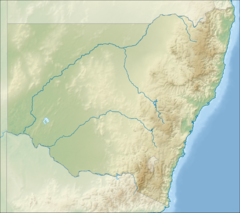Mount Kaputar National Park
| Mount Kaputar National Park | ||
|---|---|---|
| View from Mount Kaputar to the west | ||
|
|
||
| Location: | New South Wales , Australia | |
| Specialty: | old volcanic landscape, waterfall | |
| Next city: | Narrabri | |
| Surface: | 368.17 km² | |
| Founding: | 1959 | |
The Mount Kaputar National Park is a national park in north-eastern Australian state of New South Wales , 570 kilometers north-west of Sydney and 50 kilometers east of Narrabri . In the center of the park is Mount Kaputar , a volcano that was active until 17-21 million years ago. Millions of years of erosion have since transformed the volcanic region into the lava terraces , lava pillars and dykes of the Nandewar Range . Mount Kaputar is 1510 meters high and gave the park its name. The 360 ° panorama from its summit shows around ten percent of the area of New South Wales, corresponding to around 80,000 km².
The park protects a number of biomes , such as semi-arid, light woodland, sub-alpine heathland and eucalyptus forests , and provides habitats for a number of animals, such as bats , birds , wallabies , marten and the rare red triangle slug ( Red Triangle Slug , Triboniophorus graeffei), which usually appears after rainfall.
history
Before it was rededicated as a national park, the area was mainly used as pasture for cattle. The living conditions in this area are very harsh, but there were many settler families living there, and traces of their life can still be found today. Sheep and cattle grazed on the plateau until the 1950s. The area was very remote and the stickmen who looked after the cattle often did not see a soul for months.
In 1925, around 775 hectares around Mount Kaputar were designated as a recreation area. Two years later, the Mount Kaputar Trust was established to manage the park. The park area was expanded to 14,244 hectares and finally declared a national park in 1959. Eight years later, in 1967, the Trust ceded its duties to the newly formed National Parks and Wildlife Service , and the park is still managed by a regional board of directors to this day.
Facilities and leisure activities
In 1965, two cabins were built in Dawsons Spring for tourists to sleep in, with running water for showers and toilets and a picnic area. Today there are three huts including the Bark Hut .
The park is popular with climbers and there are eleven hiking trails in the park and a campsite. The most popular place in the park, however, is the Scutts Hut above the Kurrawonga Falls . The hut is the former home of the Scutt family , a settler family who lived near what is now the park. You can reach them via a fire brigade entrance way from the campsite at the Bark Hut. The hut has been restored true to the original and has a clay floor and an open fireplace. It stands on the banks of Horsearm Creek , which feeds Kurrawonga Falls.
Web links
Individual evidence
- ↑ a b c Mount Kaputar National Park Information. PleaseTakeMeTo.com ( Memento of the original from January 31, 2013 in the web archive archive.today ) Info: The archive link was automatically inserted and not yet checked. Please check the original and archive link according to the instructions and then remove this notice.
- ↑ a b c Mount Kaputar National Park . NSW Environment & Heritage Office
- ↑ a b c d Mount Kaputar National Park - Culture and History . NSW Environment & Heritage Office
- ↑ a b Mount Kaputar National Park - Exploring Cultural Heritage in the Park . NSW Environment & Heritage Office

